Traditional recognition methods—paper certificates tacked to bulletin boards, static trophy cases, faded photos in forgotten hallways—fail to capture the attention of today’s digitally native students. Modern schools require recognition solutions that match contemporary expectations for interactivity, multimedia storytelling, and immediate access to information. Interactive boards deliver these capabilities while solving the fundamental limitations of physical recognition systems: limited space, outdated content, and passive viewing experiences that fail to inspire.
Schools across the country are discovering that interactive boards transform recognition from an afterthought into a cornerstone of school culture. These sophisticated touchscreen systems enable students to explore achievements through intuitive navigation, watch video highlights of memorable moments, search for specific athletes or scholars, and connect with inspiring stories that demonstrate pathways to success. The technology creates recognition experiences that resonate with contemporary students while honoring the timeless importance of celebrating achievement.
This comprehensive guide explores how interactive boards revolutionize student recognition, what features drive engagement and success, implementation strategies that ensure maximum impact, and real-world examples demonstrating transformative results. Whether you’re establishing recognition programs for the first time or modernizing existing displays that have grown stale, interactive board technology provides scalable solutions that grow with your institution while celebrating every achievement with appropriate depth and visibility.
Understanding Interactive Board Technology
Interactive boards fundamentally reimagine recognition through digital touchscreen technology that transforms passive displays into engaging, exploratory experiences.
What Makes Recognition Boards Interactive?
True interactivity extends far beyond simply adding a screen to a wall. Effective interactive boards incorporate multiple dimensions of engagement that work together to create compelling user experiences:
Active Exploration
- Visitors control their own discovery journey
- Content responds immediately to user choices
- Multiple pathways based on individual interests
- Personalized experiences rather than fixed sequences
- Natural, intuitive touchscreen interactions
Multimedia Storytelling
- High-resolution photos showcasing achievements
- Video highlights bringing moments to life
- Audio testimonials from students and coaches
- Interactive timelines showing progress
- Document archives preserving history
The combination of user control and rich multimedia transforms how students and visitors engage with recognition. Research in educational technology demonstrates that interactive content generates 3-5 times longer engagement compared to static displays, creating deeper connections with achievement narratives and stronger motivation to pursue excellence.

The Psychology Behind Interactive Recognition
Interactive boards leverage fundamental psychological principles that drive engagement and motivation:
Curiosity and Discovery: Touchscreen interfaces invite exploration by their very nature. The ability to touch, swipe, and discover creates intrinsic motivation to engage. Students who might walk past static displays spend minutes exploring interactive content, driven by natural curiosity about their peers’ achievements and their own potential pathways.
Personal Connection: When students can search for classmates, teammates, or siblings, recognition becomes personally relevant rather than abstract. This relevance transforms casual viewers into engaged explorers actively seeking connections to their own experiences and communities.
Achievement Modeling: Interactive boards enable students to explore detailed achievement pathways, seeing not just what peers accomplished but how they got there. Video interviews, progression timelines, and comprehensive profiles demonstrate that excellence results from specific actions and sustained effort—making achievement feel attainable rather than mysterious.
Social Validation: Recognition displayed prominently in high-traffic areas communicates that the school community genuinely values achievement. When students see peers celebrated through sophisticated, engaging technology, they understand that excellence matters and merits investment in quality recognition.
For schools seeking to build recognition cultures that genuinely motivate students, interactive digital displays provide psychological advantages that static systems simply cannot match.
Core Features That Drive Engagement
Successful interactive boards combine essential capabilities with innovative features that delight users and encourage repeated exploration.
Essential Interactive Capabilities
Intuitive Touchscreen Navigation
Modern students expect interfaces as responsive and intuitive as their smartphones. Quality interactive boards deliver:
- Natural gestures: swipe, pinch, zoom, tap, scroll
- Large touch targets designed for standing interaction
- Immediate visual feedback confirming every touch
- Minimal learning curve requiring no instructions
- Accessibility features serving diverse abilities
The best systems feel effortless—visitors begin exploring without hesitation because the interface communicates its functionality through clear visual design and immediate responsiveness.
Powerful Search and Discovery
Search functionality transforms how students access recognition content:
- Name-based search with auto-complete suggestions
- Filter by graduation year, sport, or achievement category
- Keyword search across all content fields
- Browse mode for casual exploration
- Random profile features introducing unexpected discoveries
- “Related achievements” suggestions driving deeper exploration
Well-implemented search ensures that students can find specific individuals they’re seeking while also facilitating serendipitous discovery of inspiring stories they hadn’t anticipated encountering.

Rich Multimedia Integration
Interactive boards excel when they incorporate diverse content types that bring achievements to life:
Visual Content
- Professional photography of students
- Action shots capturing memorable moments
- Team photos preserving group achievements
- Awards and certificates digitally preserved
- Historical images connecting past and present
- Photo galleries showing progression over time
Video Elements
- Championship game highlights
- Student testimonials and reflections
- Coach interviews providing context
- Award ceremony footage
- Documentary-style profiles
- Before-and-after training progressions
Audio Components
- Student voices sharing their stories
- Coach commentary on achievements
- Oral histories from alumni
- Motivational messages for current students
- Podcast-style content exploring journeys
Quality touchscreen software for recognition makes multimedia integration straightforward through intuitive content management that empowers non-technical staff to create rich interactive experiences without specialized expertise.
Advanced Features That Differentiate Excellence
Personalization and Smart Recommendations
Sophisticated interactive boards learn from usage patterns to enhance discovery:
- “Students also viewed” suggestions based on viewing patterns
- Related athlete connections through shared teams or achievements
- Personalized content highlighting relevant class years or sports
- Saved favorites allowing visitors to bookmark interesting profiles
- Email or social sharing for compelling content
Social Integration Features
Modern recognition extends beyond physical displays:
- QR codes linking to extended online profiles
- Social media sharing with formatted graphics
- Email-yourself options for further exploration
- Alumni networking connection opportunities
- Community comment and memory features
These social features bridge physical installations and digital engagement, extending recognition reach far beyond those who can physically visit campus.
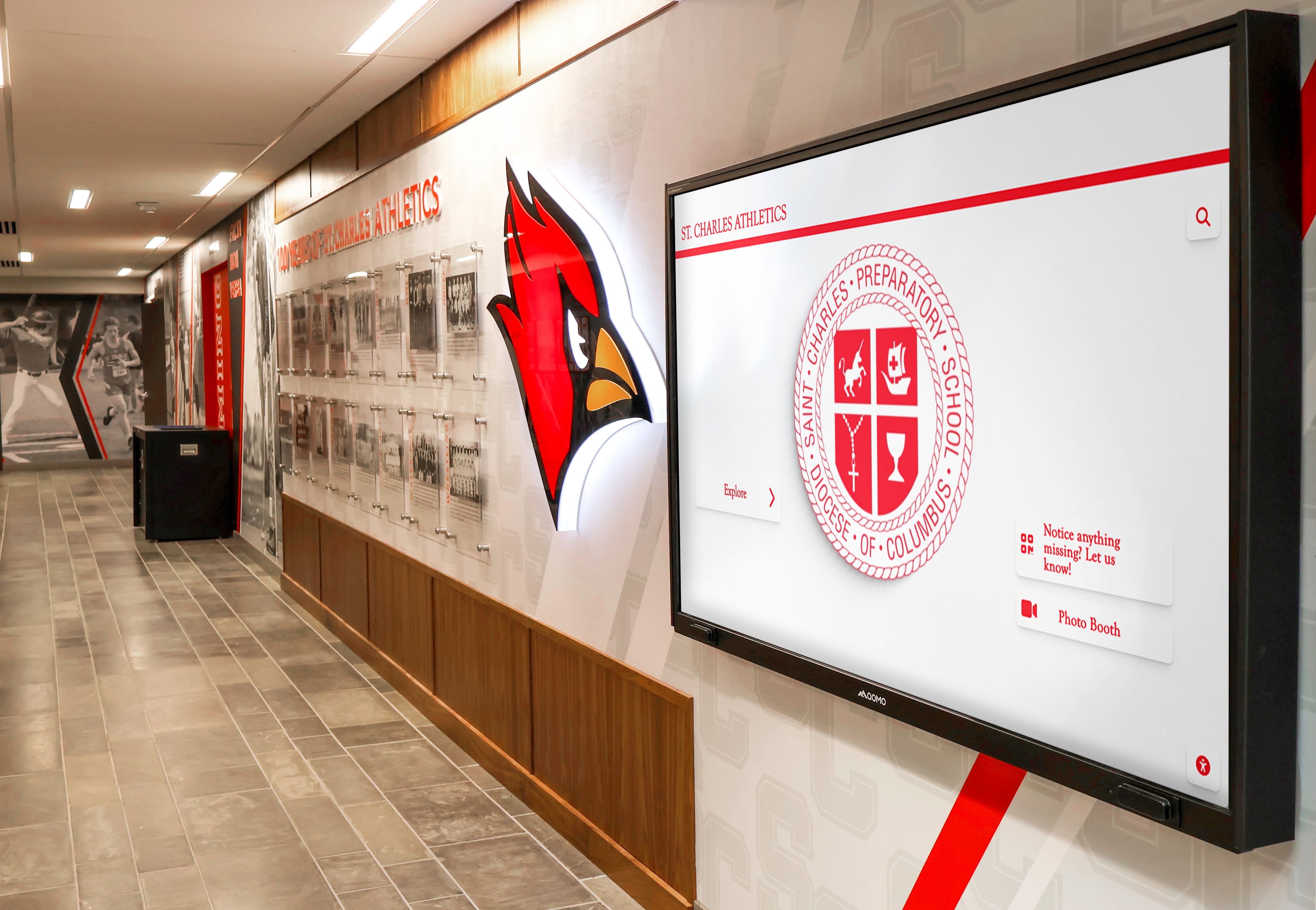
Gamification Elements
Thoughtfully implemented gamification increases engagement without trivializing achievement:
- Discovery Challenges: “Find all state champions” or “Explore athletes from your graduation year”
- Progress Tracking: Visual indicators showing exploration breadth
- Achievement Badges: Recognition for thorough exploration
- Trending Content: Most-viewed profiles and popular searches
- Interactive Quizzes: Test knowledge about school history and achievements
When implemented tastefully, gamification transforms casual browsers into engaged explorers invested in comprehensive discovery of their school’s achievement story.
Implementation Strategies for Maximum Impact
Technology enables interactivity, but strategic implementation creates sustained engagement and meaningful recognition culture change.
Location Strategy and Placement
High-Traffic Area Selection
Interactive board placement fundamentally determines visibility and usage. Optimal locations include:
- Main entrance lobbies where all visitors pass
- Athletic facility entrances accessed by teams daily
- Cafeteria or commons areas with extended dwell time
- Gymnasium lobbies with event-day traffic
- Library or academic centers serving diverse students
The key is identifying spaces where students naturally gather or pause rather than merely transit. Locations with 5-10 minutes of natural dwell time enable meaningful interaction rather than rushed glances.
Viewing Distance and Screen Size
Match screen size to typical viewing distance for comfortable interaction:
43-55 Inch Displays
- Intimate viewing spaces (8-12 feet)
- Small lobby areas
- Individual or small group interaction
- Hallway installations with closer approach
- Budget-conscious implementations
55-75 Inch Displays
- Standard lobby installations (10-15 feet)
- Common areas with moderate traffic
- Group viewing and individual exploration
- Balanced visibility and cost
- Most common implementation size
75-98 Inch Displays
- Large gathering spaces (15-25 feet)
- Prominent lobby statements
- Event spaces with crowd viewing
- Maximum visibility and impact
- Premium installations
For comprehensive guidance on placement decisions, schools should review resources about choosing the right screen size for recognition displays.

Content Development for Engagement
Creating Compelling Student Profiles
The difference between functional and exceptional interactive boards lies in content quality:
Example - Basic Profile: “Sarah Johnson - Class of 2024 - Varsity Soccer, 3.8 GPA”
Example - Compelling Profile: “Sarah Johnson transformed the varsity soccer program during her four years, captaining the team to three conference championships while maintaining a 3.8 GPA in advanced coursework. Her dedication extended beyond the field—Sarah volunteered 200+ hours with youth soccer clinics, demonstrating the leadership and service that defined her high school career. Teachers remember her insightful classroom discussions and willingness to help struggling classmates. Now pursuing sports medicine at State University, Sarah credits her coaches and teammates with teaching her resilience, teamwork, and the work ethic that continues driving her success.”
The second example tells a story that helps students understand not just what Sarah accomplished but who she is and how she got there—providing a concrete model for their own potential journeys.
Multimedia Content Strategy
Develop content systematically across multiple formats:
Phase 1 - Foundation Content (Launch)
- Professional photographs for all recent recognitions
- Basic biographical information and achievements
- Graduation years and primary accomplishments
- Sport or activity affiliations
- Awards and honors received
Phase 2 - Enhanced Content (3-6 Months)
- Extended written profiles with narratives
- Additional photo galleries showing progression
- Coach or teacher testimonial quotes
- Achievement timelines and statistics
- Related student connections
Phase 3 - Premium Content (6-12 Months)
- Video interviews with students
- Game or performance highlights
- Documentary-style mini-profiles
- Alumni update features
- Historical depth for older achievements
This phased approach enables timely launch with strong foundational content while creating a roadmap for continuous enrichment that keeps the interactive board fresh and engaging over time.
Balancing Historical Depth and Current Recognition
Effective interactive boards celebrate both legacy and present:
- Recent Achievements (Last 5 Years): 60-70% of featured content, comprehensive coverage, rich multimedia
- Historical Excellence (5-20 Years): 20-30% of content, notable achievements, growing over time
- Legacy Achievements (20+ Years): 10-20% of content, significant milestones, historical context
This balance ensures current students see themselves and peers prominently while understanding their place in longer achievement traditions.
For schools digitizing extensive historical recognition, resources about digitizing plaques and trophies provide systematic approaches for converting physical archives to engaging digital content.
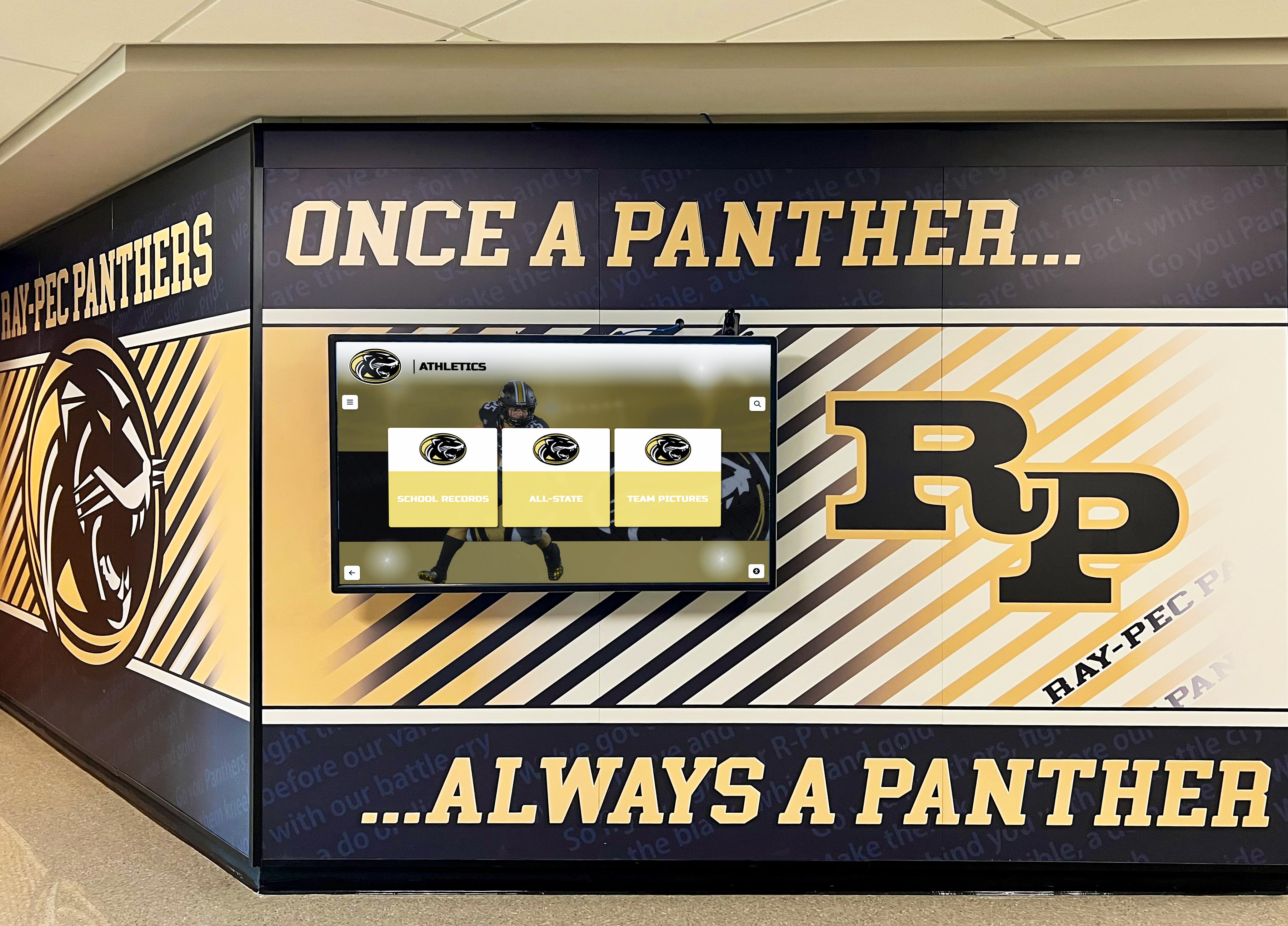
User Experience Design Principles
Intuitive Navigation Architecture
Content organization determines whether visitors explore effortlessly or become frustrated:
Clear Category Structure
- Primary categories immediately visible (Athletics, Academics, Arts, Service, Leadership)
- Subcategories logically nested under main topics
- Visual icons supporting text labels
- Consistent placement of navigation elements
- Breadcrumb trails showing current location
- Easy return to home screen
Progressive Disclosure of Information
Layer content depth serving both casual browsers and deep explorers:
Summary Level: Name, photo, graduation year, primary achievement (5-10 seconds) Detail Level: Full biography, photo gallery, achievement timeline, awards (30-90 seconds) Deep Exploration: Video interviews, statistics, related students, complete history (2-5 minutes)
This layered approach ensures quick browsers find highlights while interested visitors can explore comprehensively without feeling overwhelmed by information density.
Visual Design Excellence
Compelling visual design transforms functional interfaces into engaging experiences:
- Institutional Branding: Color schemes, typography, and imagery reflecting school identity
- High Contrast: Ensuring readability in various lighting conditions
- Strategic White Space: Preventing visual overwhelm and guiding attention
- Consistent Visual Language: Maintaining coherent design throughout all screens
- Smooth Animations: Confirming interactions without distracting from content
Professional user interface design for recognition displays balances aesthetic appeal with functional clarity, creating systems that feel both beautiful and effortless.
Measuring Success and Optimizing Performance
Data-driven optimization ensures interactive boards deliver maximum value and continuously improve.
Analytics That Drive Improvement
Modern interactive systems provide rich engagement data revealing how students interact:
Usage Metrics
- Total daily interactions and unique visitors
- Average session duration (target: 3-7 minutes)
- Interactions per session (target: 8-15 screens)
- Peak usage times and days
- Repeat visitor percentages
Content Performance
- Most viewed student profiles
- Popular search terms revealing student interests
- Category browsing preferences
- Video completion rates
- Photo gallery engagement levels
Navigation Patterns
- Common exploration pathways
- Search versus browse ratios
- Navigation depth (screens per session)
- Feature utilization rates
- Abandonment points requiring improvement
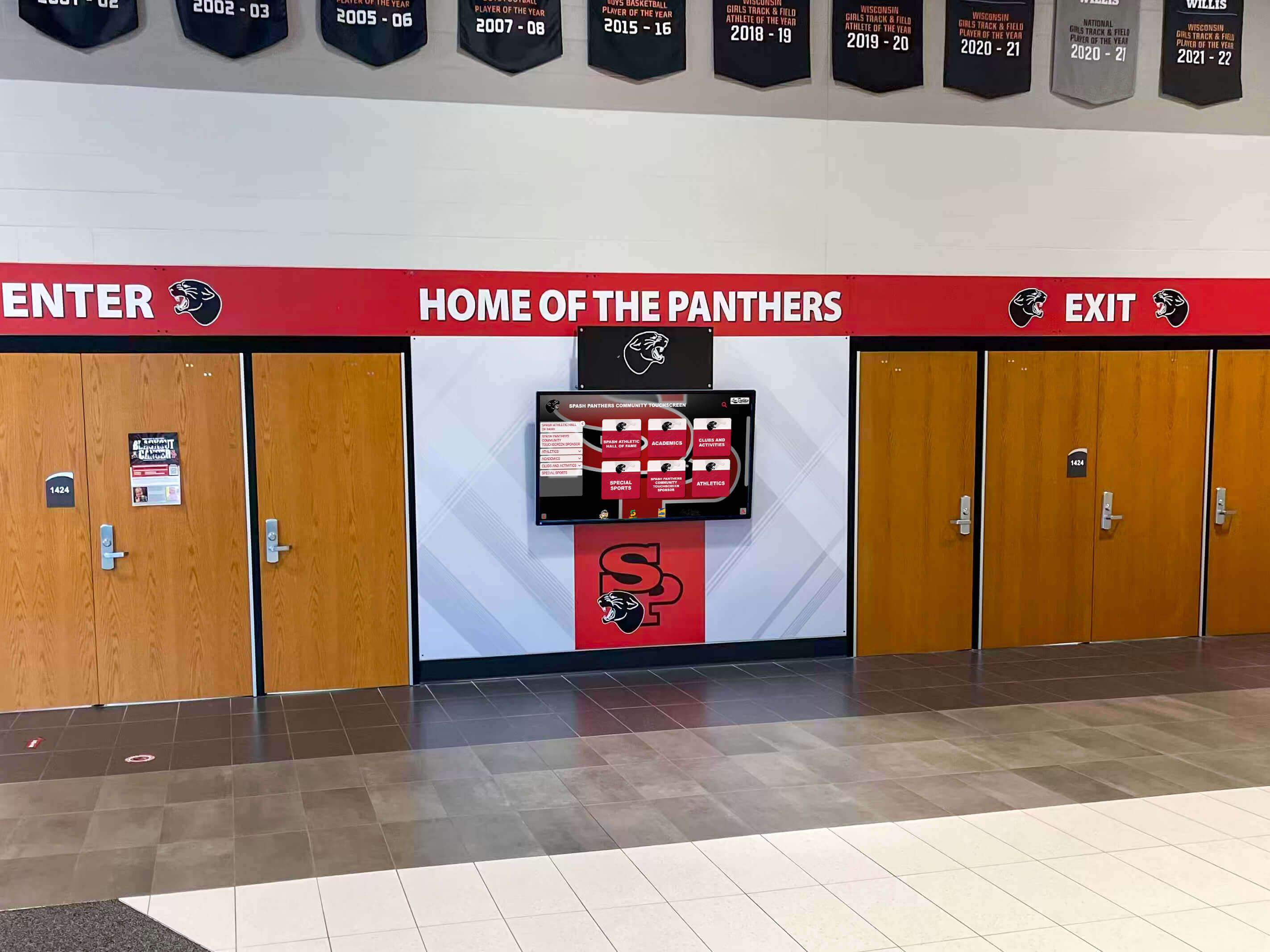
Optimization Based on Data
Transform analytics into continuous improvement:
Content Optimization Strategies
- Feature underutilized but valuable profiles more prominently
- Expand categories showing high engagement
- Add content in areas with high search volume but limited results
- Improve quality of profiles with low engagement metrics
- Create thematic collections based on popular searches
User Experience Refinements
- Simplify navigation paths showing high abandonment
- Enhance features with strong engagement metrics
- Remove or redesign underutilized capabilities
- Adjust touch target sizes based on interaction accuracy
- Optimize attract mode content for better initial engagement
Institutional Value Demonstration
Use data to justify investment and secure ongoing support:
- Track total annual interactions demonstrating community engagement
- Calculate time saved versus manual recognition updates
- Document cost-per-recognition compared to traditional methods
- Connect engagement data to school pride and alumni satisfaction metrics
- Correlate recognition visibility with student motivation indicators
For comprehensive approaches to analytics and optimization, schools can explore measuring digital recognition success.
Qualitative Success Indicators
Beyond quantitative metrics, qualitative evidence reveals true impact:
- Student testimonials about inspiration from peer achievements
- Family feedback about engagement and pride
- Coach observations about increased team motivation
- Alumni comments on enhanced connection to school
- Visitor reactions during tours and events
- Social media mentions and shares
- Media coverage highlighting the installation
- Recruitment impact testimonials
Technology Selection and Platform Considerations
Choosing appropriate technology ensures your interactive vision becomes reliable, sustainable reality.
Hardware Components and Specifications
Commercial-Grade Display Requirements
Interactive boards for schools demand commercial specifications:
- Operating Hours: 16-24 hour daily ratings supporting continuous operation
- Durability: Hardened glass surfaces resisting scratches and impacts
- Brightness: 350-450 nits ensuring visibility in typical school lighting
- Resolution: Minimum 1080p, 4K for premium presentation quality
- Touch Technology: Capacitive or infrared multi-touch for responsive interaction
- Warranty: Minimum 3-year commercial coverage with on-site service
Consumer displays designed for residential use typically fail within 18-24 months under school usage patterns. The higher initial cost of commercial displays delivers significantly lower total cost of ownership through longer lifespan and reduced replacement frequency.
Computing Requirements
Adequate computing power ensures smooth, responsive interaction:
- Processor: Intel i5 or equivalent for complex interactive content
- Memory: Minimum 8GB RAM for multimedia playback
- Storage: 256GB+ SSD for fast content loading
- Graphics: Dedicated GPU for smooth animation and 4K displays
- Connectivity: Gigabit Ethernet preferred over WiFi for reliability
For detailed hardware selection guidance, schools should review hardware selection guides for digital recognition.
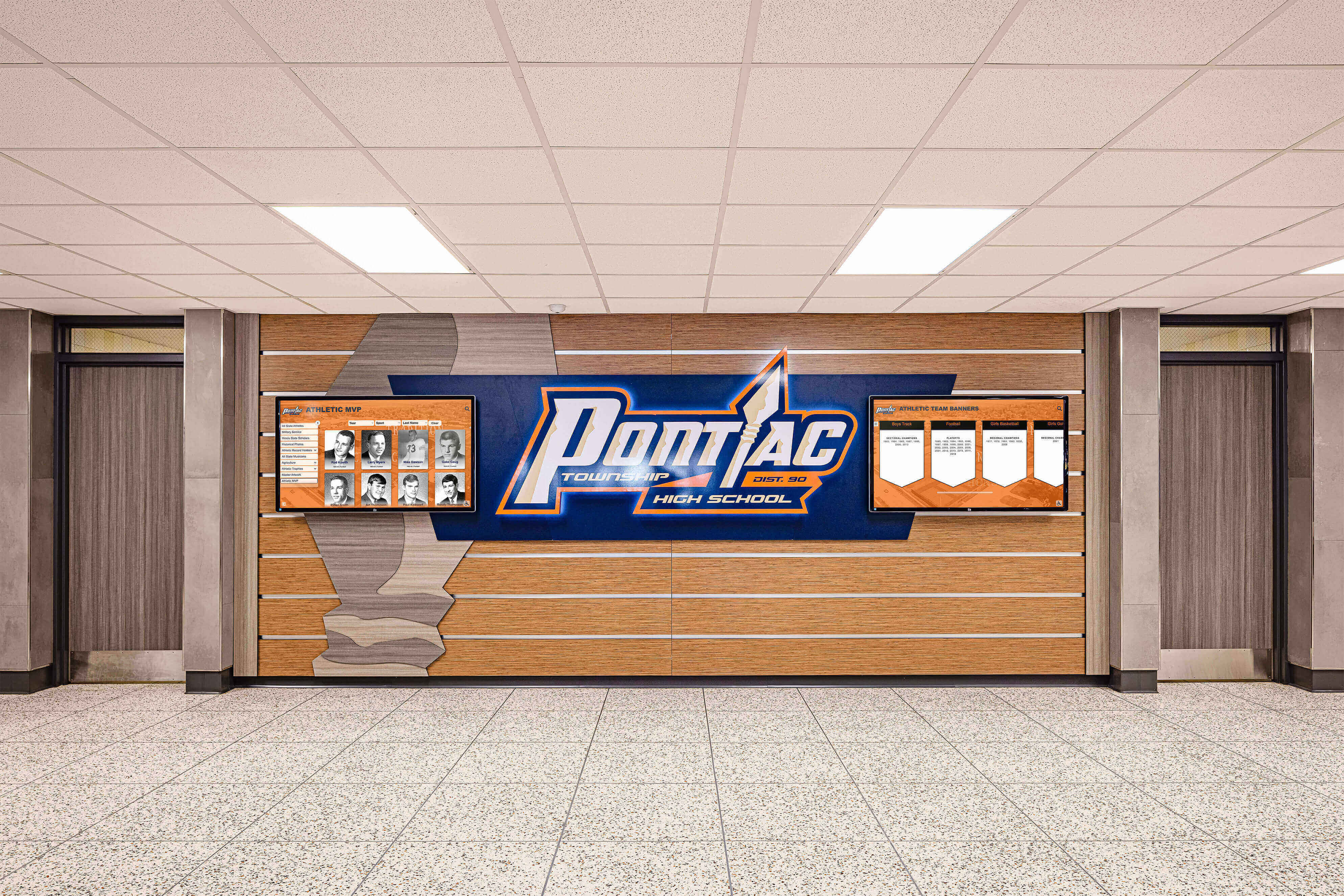
Software Platform Evaluation
Essential Platform Capabilities
The software platform fundamentally determines long-term value:
Content Management
- Intuitive interfaces requiring no technical expertise
- Drag-and-drop media upload and organization
- Template-based profile creation for consistency
- Bulk import capabilities for large data sets
- Scheduled publishing and content rotation
- Multi-user access with role-based permissions
Interactive Features
- Responsive touchscreen interface design
- Comprehensive search and filtering
- Multimedia support (photos, videos, audio, documents)
- Analytics and reporting dashboards
- Cloud-based access for remote management
- Regular platform updates and new features
Integration Capabilities
- Student information system connectivity
- Website embedding options
- Social media sharing tools
- Mobile companion app support
- API access for custom integrations
Solutions like Rocket Alumni Solutions provide purpose-built platforms designed specifically for school recognition rather than generic digital signage systems adapted for the purpose. Purpose-built solutions deliver superior functionality, better support, and features addressing the unique needs of educational recognition.
Ongoing Support and Service
Evaluate vendor support capabilities carefully:
- Technical support availability and response times
- Training programs for administrators
- Regular software updates and feature additions
- Content development assistance services
- Hardware maintenance options
- Long-term platform viability and roadmap
Quality vendors view implementation as the beginning of a partnership rather than a one-time transaction, providing ongoing support ensuring long-term success.
Best Practices from Successful Implementations
Learning from schools that have implemented effective interactive boards accelerates success and avoids common pitfalls.
Start with Content-First Strategy
Technology amplifies content quality—or exposes its absence. Successful schools:
- Develop comprehensive content plans before launch
- Gather student achievement information systematically
- Photograph subjects professionally or train student photographers
- Write compelling narratives rather than basic facts
- Pilot content with focus groups before full launch
- Establish sustainable update workflows from day one
Launching with thin content undermines the entire investment. Students who explore an interactive board and find minimal information rarely return, while those who discover rich, engaging content become regular users and advocates.
Design for Your Specific Student Culture
Generic interactive experiences underperform compared to tailored implementations:
Elementary Schools
- Simplified navigation appropriate for younger students
- Heavy emphasis on visual content and animation
- Character and citizenship recognition alongside academics
- Classroom-level recognition celebrating all students
- Parent-friendly features supporting family engagement
Middle Schools
- Peer-focused content highlighting student achievements
- Balance between individual and team recognition
- Age-appropriate multimedia and storytelling
- Social features enabling appropriate sharing
- Categories recognizing diverse talents and growth
High Schools
- Sophisticated search for larger student populations
- College and career connection emphasis
- Comprehensive achievement documentation
- Social media integration for broader reach
- Alumni networking and mentorship features
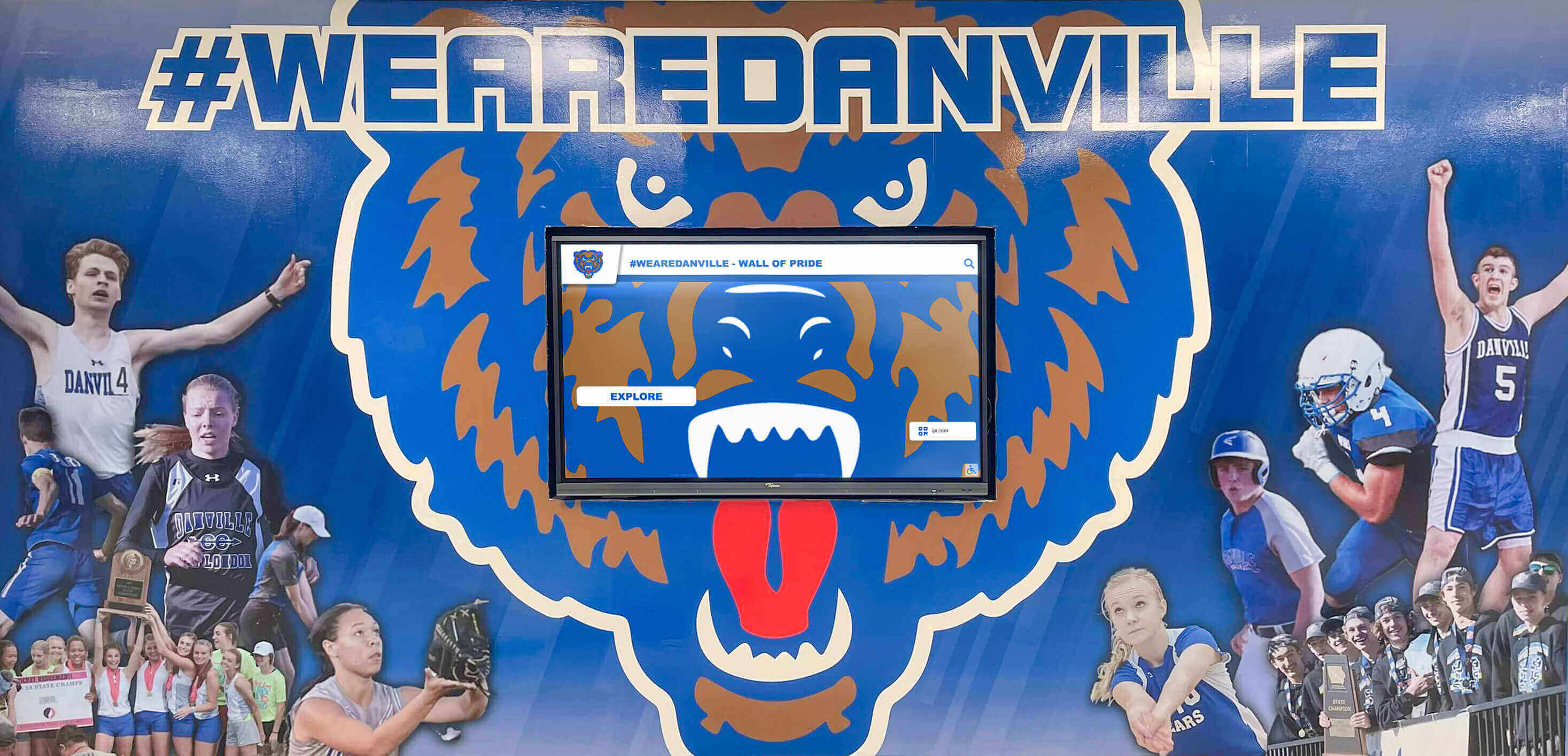
Promote Consistently and Creatively
Even excellent interactive boards require ongoing promotion:
Launch Phase
- School-wide announcement assemblies
- Student demonstrations during orientations
- Parent communication through newsletters
- Social media campaigns with behind-the-scenes content
- Local media coverage of the installation
- Grand opening events with student honorees
Ongoing Promotion
- Regular announcements highlighting new content
- Integration into campus tours for prospective families
- Classroom lessons using the board for research
- Competitions encouraging exploration
- Seasonal content themes drawing attention
- Event-driven features during homecoming, graduations, reunions
Social Integration
- Instagram posts featuring student profiles
- Weekly “throwback” content highlighting historical achievements
- Student takeovers showcasing different perspectives
- Alumni engagement campaigns
- Parent sharing opportunities
Sustained promotion maintains awareness and usage, preventing the board from fading into background wallpaper that students ignore.
Maintain Momentum Through Regular Updates
Interactive displays succeed when they evolve continuously:
Content Update Schedule
- Weekly: Featured profile rotation, new achievement highlights
- Monthly: New inductee additions, category expansions
- Quarterly: Multimedia enhancement for existing profiles, thematic collections
- Seasonally: Sport-specific content tied to active seasons, graduation recognition
- Annually: Historical expansion projects, major content campaigns
Static content causes engagement to decline rapidly. Students who see the same featured content week after week stop checking for updates. Regular refresh maintains interest and communicates that recognition is current and ongoing rather than historical and complete.
For schools establishing sustainable practices, resources about maintaining and updating digital recognition displays provide systematic approaches ensuring long-term success.
Common Implementation Challenges and Solutions
Understanding predictable obstacles helps schools navigate them effectively:
Challenge: Content Development Takes Longer Than Expected
Solution: Implement in phases starting with recent, well-documented achievements. Engage students directly to contribute information about their own accomplishments. Consider professional content development services for jumpstart. Establish sustainable workflows rather than treating content as one-time project.
Challenge: Lower Than Hoped Initial Engagement
Solution: Position displays in higher-traffic locations if possible. Promote extensively through multiple channels. Create programs specifically driving traffic to the board (scavenger hunts, required assignments). Add compelling new content regularly. Gather user feedback identifying improvement opportunities.
Challenge: Staff Concerns About Managing Technology
Solution: Choose platforms with genuinely intuitive interfaces requiring minimal training. Provide hands-on practice sessions rather than lecture-based training. Create simple reference guides for common tasks. Establish internal support networks among tech-comfortable staff. Maintain vendor support relationships for complex issues.
Challenge: Technical Issues During Implementation
Solution: Work with experienced vendors offering comprehensive support. Build timeline buffers for problem resolution. Conduct thorough testing before public launch. Have backup plans for launch events. Document configurations thoroughly for troubleshooting.
Challenge: Securing Ongoing Funding for Expansion
Solution: Track and report engagement metrics demonstrating value. Connect recognition to measurable school outcomes (pride, motivation, alumni engagement). Create naming opportunities for donors. Implement phased expansion tied to results. Secure annual operating budget allocation rather than one-time funding.
The Future of Interactive Recognition Technology
Interactive board technology continues evolving with emerging capabilities that will shape next-generation recognition:
Artificial Intelligence Integration
AI technologies enhance personalization and automation:
- Intelligent content recommendations based on user behavior
- Automated profile generation from public sources
- Natural language search and conversational interfaces
- Facial recognition for personalized greetings
- Content gap identification suggesting additions
- Predictive analytics forecasting engagement patterns
Enhanced Mobile Integration
Deeper mobile connections amplify accessibility:
- Progressive web apps providing phone access to all content
- Mobile-first content creation tools for easy updates
- Push notifications about new recognitions or content
- Augmented reality features overlaying information
- Personal achievement portfolios for students
- Parent dashboards tracking recognition history
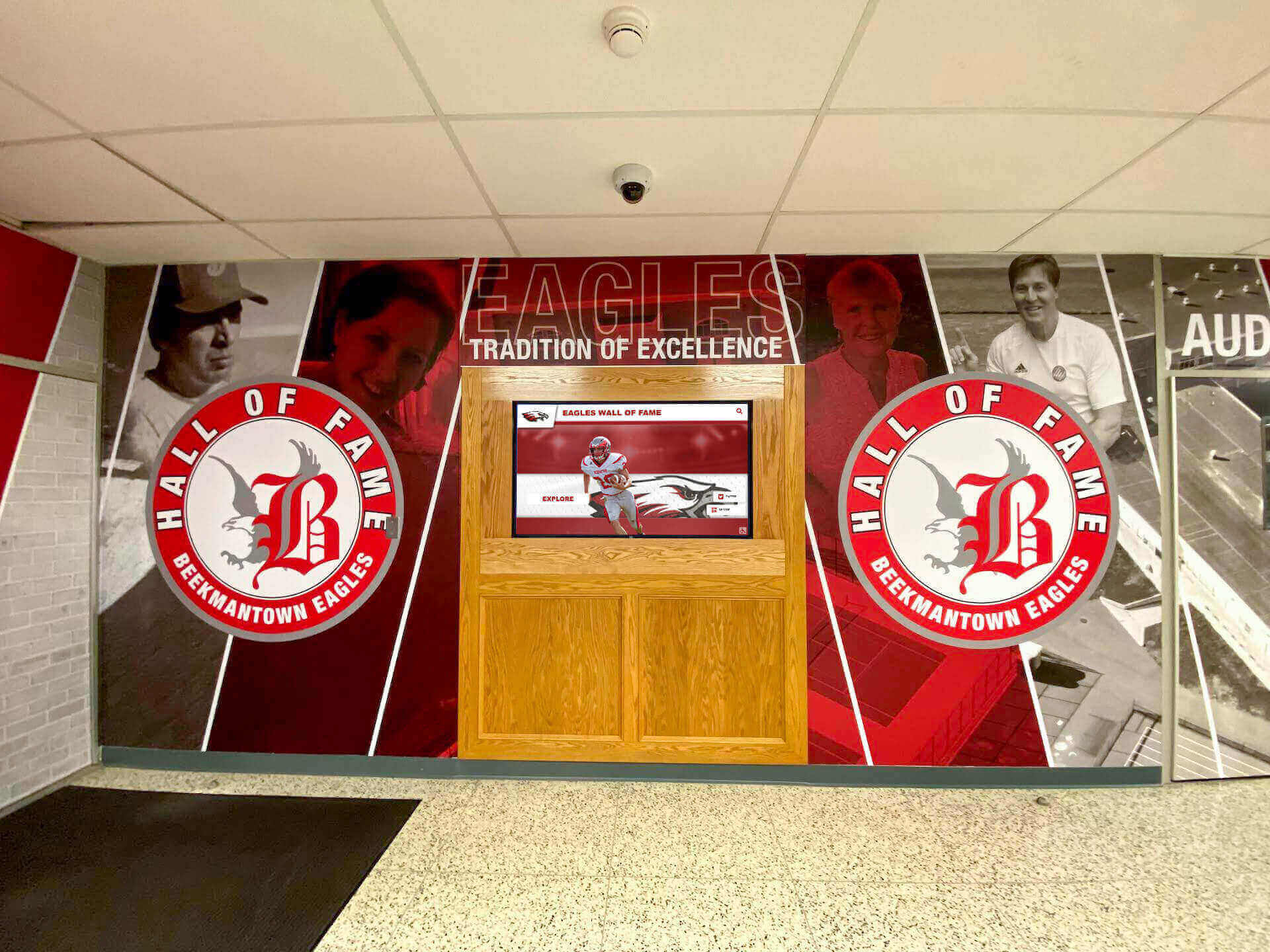
Voice Interaction Capabilities
Emerging voice technology adds accessibility:
- Voice-activated search and navigation
- Audio descriptions for visual content
- Conversational interfaces enabling natural queries
- Hands-free operation for accessibility
- Multiple language support through voice
- Read-aloud capabilities for text content
Advanced Analytics and Insights
Machine learning optimizes experiences automatically:
- Automated A/B testing of interface variations
- Predictive featured content based on upcoming events
- Anomaly detection identifying technical issues
- Engagement forecasting supporting planning
- Personalized experiences for returning visitors
- Behavioral insights informing content strategy
Organizations staying current with emerging trends in recognition technology maintain competitive advantages and maximize long-term value from their interactive systems.
Transforming School Culture Through Interactive Recognition
Interactive boards represent more than technology upgrades—they’re catalysts for cultural transformation in how schools celebrate achievement and engage their communities.
Building Recognition-Centered School Culture
When implemented thoughtfully, interactive boards become cornerstones of recognition culture:
Visibility and Accessibility: Prominent placement in high-traffic areas communicates that achievement matters. Easy access through intuitive interfaces ensures recognition is inclusive rather than exclusive.
Comprehensiveness Over Selectivity: Unlimited digital capacity enables celebrating diverse achievements across academics, athletics, arts, service, and leadership—demonstrating that multiple pathways to excellence exist and merit recognition.
Currency and Relevance: Regular updates with current achievements show recognition as ongoing rather than historical, maintaining relevance for contemporary students.
Depth and Context: Rich multimedia profiles provide context showing not just what students achieved but how they got there, making excellence feel attainable rather than mysterious.
Inspiration Through Modeling: Seeing peers celebrated for specific achievements creates concrete models students can emulate, translating abstract expectations into visible examples.
Connecting Recognition to Broader School Goals
Interactive boards support multiple institutional priorities beyond simple recognition:
Student Motivation: Research demonstrates that visible peer achievement recognition increases student motivation and goal-setting. Interactive boards make recognition impossible to miss.
School Pride: Celebrating accomplishments publicly builds collective pride in school identity and tradition. Interactive engagement amplifies pride through active exploration rather than passive viewing.
Family Engagement: Accessible recognition creates positive touchpoints for family interaction with schools. Parents explore achievements enthusiastically, strengthening school-family relationships around celebration rather than only connecting during problem-focused conferences.
Alumni Connection: Interactive boards accessible online extend recognition to alumni worldwide. This accessibility strengthens alumni networks and supports advancement efforts through enhanced connection.
Recruitment Advantage: Prospective families exploring recognition displays understand the school values achievement and invests in celebrating students—creating competitive recruitment advantages.
For schools seeking to leverage recognition as cultural strategy, building positive school culture through digital recognition provides comprehensive approaches connecting recognition to broader institutional goals.
Getting Started: Implementation Roadmap
Schools ready to implement interactive boards benefit from systematic approaches ensuring successful deployment.
Phase 1 - Planning and Assessment (Months 1-2)
- Form implementation team including diverse stakeholders
- Define recognition goals and intended outcomes
- Assess available locations and technical requirements
- Develop preliminary budget and secure funding
- Research vendors and platform options
- Create content inventory of existing recognition materials
Phase 2 - Vendor Selection and Design (Months 2-3)
- Request vendor demonstrations and proposals
- Evaluate platforms against requirements
- Check references from similar schools
- Select vendor and finalize specifications
- Design user interface and navigation structure
- Plan content categories and organization
- Establish branding and visual design
Phase 3 - Content Development (Months 3-5)
- Gather student achievement information systematically
- Photograph subjects and digitize existing materials
- Write compelling student profiles and narratives
- Create video content through interviews
- Organize content using consistent structure
- Review and edit for quality and accuracy
- Load initial content into management system
Phase 4 - Installation and Testing (Month 5)
- Complete site preparation and technical infrastructure
- Install display hardware and configure software
- Conduct comprehensive functionality testing
- Train staff on content management and operation
- Perform soft launch with pilot users
- Gather feedback and refine based on testing
Phase 5 - Launch and Ongoing Operations (Month 6+)
- Host grand opening event generating awareness
- Implement promotional campaigns driving usage
- Monitor analytics and gather user feedback
- Continue systematic historical content addition
- Establish regular update processes and schedules
- Plan future expansion based on success metrics
Conclusion: Celebrating Every Achievement with Excellence
Interactive boards transform how schools recognize student achievement—moving from passive displays that students ignore to engaging experiences that inspire exploration, build pride, and motivate excellence. The technology addresses fundamental limitations of traditional recognition while creating new possibilities for celebrating achievement with the depth, accessibility, and engagement that contemporary students expect and deserve.
Successful implementation requires more than purchasing equipment—it demands strategic planning, compelling content development, thoughtful design, ongoing optimization, and sustained commitment to maintaining relevance. Schools that approach interactive boards systematically, learning from successful implementations and avoiding common pitfalls, create recognition programs that deliver value far exceeding their investment through enhanced student motivation, stronger school culture, deeper family engagement, and expanded alumni connections.
The students walking your hallways today achieve remarkable things every day—in classrooms, on fields and stages, through service and leadership. Interactive boards ensure these achievements receive recognition that matches their significance, creating experiences that honor the past, celebrate the present, and inspire future excellence.
Ready to transform how your school recognizes achievement? Modern solutions like Rocket Alumni Solutions provide comprehensive interactive board platforms designed specifically for schools, combining intuitive content management, engaging user experiences, and dedicated support ensuring long-term success. Every achievement deserves recognition that inspires—interactive boards make this vision reality.




































